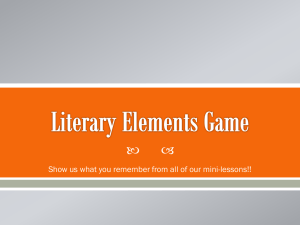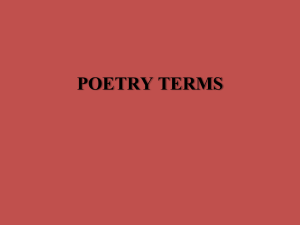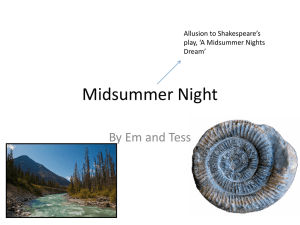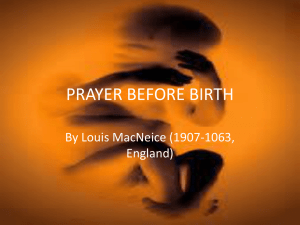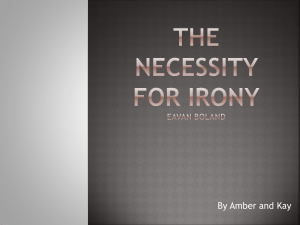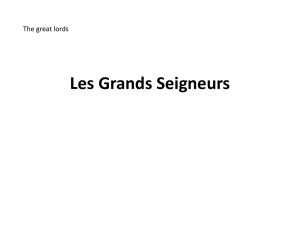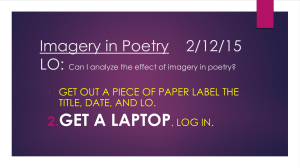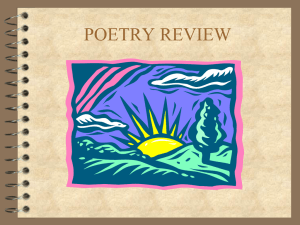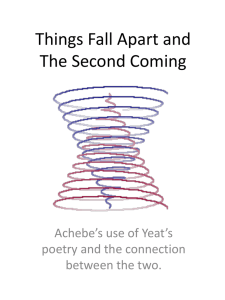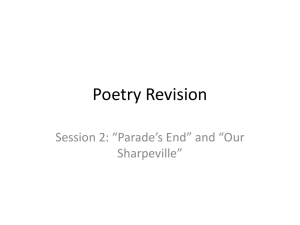Literary Terms and Activities for Poetry
advertisement
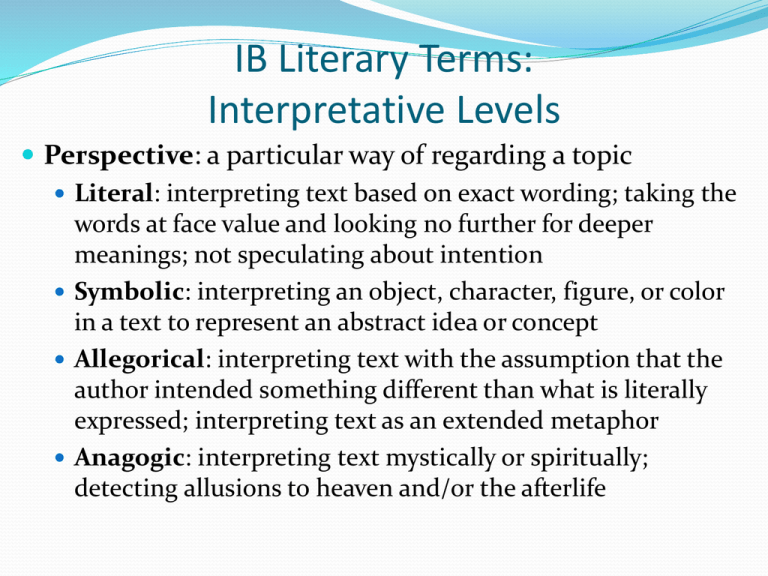
IB Literary Terms: Interpretative Levels Perspective: a particular way of regarding a topic Literal: interpreting text based on exact wording; taking the words at face value and looking no further for deeper meanings; not speculating about intention Symbolic: interpreting an object, character, figure, or color in a text to represent an abstract idea or concept Allegorical: interpreting text with the assumption that the author intended something different than what is literally expressed; interpreting text as an extended metaphor Anagogic: interpreting text mystically or spiritually; detecting allusions to heaven and/or the afterlife Interpretative Levels Applied to: “The Asparagus” Literal: The poem is about asparagus being harvested and cooked: “She can smell him steaming, his crowns/ Already tender” Symbolic: The “great beasts” represent unpleasant trials brought upon the speaker by a woman: “She sent packs of great beasts to pass/ Over him, trailing belly-fur and dust,/ Bending their nostrils to his frail spear” Allegorical: The speaker is comparing himself to an asparagus through an extended metaphor. A woman is testing the speaker almost to the breaking point: “This was to toughen him…Now he is threatening to wither terribly,/ And slip from the water altogether” Anagogic: Soon the speaker will disintegrate and all that will remain of him is his spirit: “billow through the kitchen like prayer” Applying Interpretative Levels Choose your favorite lines/sentences you wrote for the Word Gathering steps. Combine the lines/sentences into a poem of at least 12 lines. Reorder lines/sentences as necessary. Add connecting words, phrases, and lines/sentences. Divide different ideas into stanzas. When you’re done writing your poem, trade poems with a partner. On a separate sheet, write your own interpretation along with evidence from the poem for each interpretative level: literal, symbolic, allegorical, and anagogic. Poetry Techniques Poetry is a literary form characterized by a strong sense of rhythm and meter and an emphasis on the interaction between sound and sense. Form: organization/structure Rhythm: pattern of sound created by the varying length and emphasis given to different syllables Type: fixed forms that follow certain rules Poetry Techniques: Form Caesura: pause between a basic rhythmic unit (foot) and the next rhythmic unit. End stopped line: line is ended with a comma, period, semicolon, or other punctuation mark Enjambment: sentence or clause runs onto next line without a break Example: “Ode to a Nightingale” by John Keats Forlorn! the very word is like a bell To toll me back from thee to my sole self! Adieu! the fancy cannot cheat so well As she is famed to do, deceiving elf. Adieu! adieu! thy plaintive anthem fades Past the near meadows, over the still stream, Up the hill-side; and now 'tis buried deep In the next valley-glades: Was it a vision, or a waking dream? Fled is that music:—do I wake or sleep? Poetry Techniques: Form (cont.) Incremental repetition: line is repeated in a different context or with minor changes Example: “Lord Randal” “O where ha’ you been, Lord Randal, my son? And where ha’ you been, my handsome young man?” “I ha’ been at the greenwood; mother, mak my bed soon, For I’m wearied wi’ huntin’, and fain wad lie down.” “And wha met ye there, Lord Randal, my son? And wha met you there, my handsome young man?” O I met wi’ my true-love; mother, mak my bed soon, For I’m wearied wi’ huntin’, and fain wad lie down.” Poetry Techniques: Form (cont.) Stanza: group of lines, equivalent to a paragraph in prose Couplet: two successive rhymed lines of equal length Heroic couplet: pair of rhyming lines in iambic pentameter (aa rhyme scheme); last two lines in Shakespearean sonnet Quatrain: four-line stanza Heroic quatrain: four lines in iambic pentameter (abab rhyme scheme) Example: “Sonnet 29” by William Shakespeare 1) When, in disgrace with fortune and men's eyes, I all alone beweep my outcast state And trouble deaf heaven with my bootless cries And look upon myself and curse my fate, 2) Wishing me like to one more rich in hope, Featured like him, like him with friends possess'd, Desiring this man's art and that man's scope, With what I most enjoy contented least; 3) Yet in these thoughts myself almost despising, Haply I think on thee, and then my state, Like to the lark at break of day arising From sullen earth, sings hymns at heaven's gate; For thy sweet love remember'd such wealth brings That then I scorn to change my state with kings. Annotation: You will annotate copies of poems. Annotation is the process of writing critical, analytical, and explanatory notes on a copy of a work being studied. To annotate, you may include underlining, highlighting, symbols, words, phrases, and sentences within the text. The purpose of annotating poems is to practice close reading and analysis for the Oral Commentary and Papers 1 and 2. Close Reading: Linguistic reading is largely descriptive. We are noting what is in the text and naming its parts for possible use in the next stage of reading. Semantic reading is cognitive. That is, we need to understand what the words are telling us – both at a surface and maybe at an implicit level. Structural reading is analytic. We must assess, examine, sift, and judge a large number of items from within the text in their relationships to each other. Cultural reading is interpretive. We offer judgments on the work in its general relationship to a large body of cultural material outside it. Literary Elements Found in “Advertisement for the Waldorf-Astoria” Parody= satirical imitation Satire= use of irony, sarcasm, ridicule, etc. to expose human shortcomings; constructive social criticism Juxtaposition= placing two items side by side to show contrast Verbal irony= a figure of speech in which what is said is the opposite of what is meant Allusion= brief reference to a person, place, or event or to another literary work or passage Personal Summary for Future Reference: Based on your annotations for “Advertisement for the Waldorf-Astoria,” write a summary for yourself of what the poem is about and what the most important literary elements are in the poem. The purpose of this is to have a quick reference for you to study from in preparing for the oral commentary. If you did not complete all of the Interpretative Levels for a partner’s poem, write an interpretation of “Advertisement for the Waldorf-Astoria” for each level: literary, symbolic, allegorical, anagogic. Imagery: Description related to the senses Auditory: sound Gustatory : taste Olfactory: smell Tactile: touch Visual: sight Groups for Annotating “Cultural Exchange”: Relevant Research & Purpose in Poem Imagery throughout the poem Sound: alliteration, rhythm, and rhyme throughout the poem Recordings of “German lieder,” “Hesitation Blues,” “Dixie,” and “When the Saints Go Marching In” 4. Leontyne Price 5. People named in second and third stanzas on p. 478 6. People named in last stanza on p. 478 and first stanza on p. 479 7. Locations in first and second stanzas on p. 479 8. Indented names in last stanza on p. 479 9. Allusions in first stanza on p. 480 10. People named in last stanza on p. 480 11. “Mammy’s” named in last stanza on p. 481 (also define “archetype” and “caricature”) 1. 2. 3.


